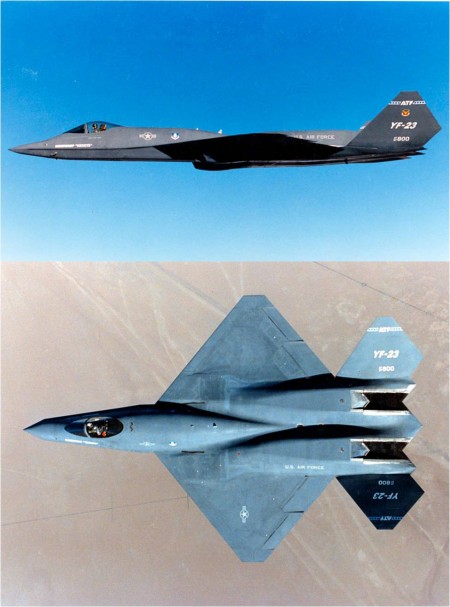Twenty-three years ago this week, the Northrop YF-23 Advanced Tactical Fighter took to the air for the first time. Veteran test pilot Paul Metz was at the controls of the revolutionary single seat, twin engine air superiority fighter aircraft.
The Advanced Tactical Fighter (ATF) was intended as a next-generation replacement for the USAF F-15 Eagle. The mission was air superiority; complete control and dominance of an adversary’s airspace under wartime conditions. Key capabilties in this role would be survivability, supercruise, stealth, and ease of maintenance.
The ATF program began in mid-1981 when USAF released a Request For Information (RFI) to the American aerospace industry. Study contracts were subsequently awarded to Boeing, General Dynamics, Grumman, Lockheed, McDonnell Douglas, Northrop, and Rockwell in September 1983. This was followed twenty-four months later with a formal Request For Proposal (RFP).
With the exception of Grumman and Rockwell, USAF received RFP responses from the awardees of the ATF study contracts in July of 1986. Just three months later, Lockheed and Northrop got the nod to go head-to-head in a competition to build and demonstrate an ATF prototype aircraft. Lockheed’s version of the ATF became known as the YF-22 while Northrop’s received the designation YF-23.
Northrop’s ATF prototype was a impressive looking aircraft where form followed function. From its diamond planform wings and area-ruled external shape to its upper surface engine exhaust troughs and all-moving V-tail assembly, the YF-23’s gifted designers created a next-generation air superiority fighter with outstanding performance and stunning visual appeal.
The YF-23 ATF measured 67.5 feet in length and had a wing span of 43.5 feet. The type’s loaded and empty weights were 51,320 lbs and 29,000 lbs, respectively. Power was provided by twin turbofan engines rated at 35,000 lbs of sea level thrust each. Performance was quite impressive with a maximum speed of 1,650 mph (Mach 2.2) and service ceiling of 65,000 feet.
Northrop built and flight-tested a pair of ATF prototype aircraft. YF-23 Prototype Air Vehicle 1 (PAV-1) carried tail number 87-0800 and was powered by Pratt and Whitney YF-119 turbofans. Called “Black Widow II, it was painted a charcoal gray. YF-23 Prototype Air Vehicle 2 (PAV-2) received tail number 87-0801 and was powered by General Electric YF-120 turbofans. PAV-2’s nickname of “Gray Ghost” derived from it having been painted in several shades of gray.
The maiden YF-23 flight took place on Monday, 27 August 1990 at Edwards Air Force Base, California. Chief Test Pilot Paul Metz put YF-23 PAV-1 through its paces during the 50-minute flight. YF-23 PAV-2 went to make its first flight on Friday, 26 October 1990 with Jim Sandberg at the controls. The pair of YF-23 aircraft went on to make 50 test sorties for a total of 65.2 hours through December 1990.
While the YF-23 was faster and had more favorable stealth characteristics, the Lockheed YF-22 was the more agile aircraft. This and other factors led to the Air Force selecting the YF-22 in April of 1991 as the winner of the ATF competition. This decision stunned many in the aerospace industry, most especially Northrop. To this day, many die-hard YF-23 adherents remain adamant that the Air Force selected the second-best ATF candidate.
YF-23 PAV-1 is currently on display in the Research and Development wing of the National Museum of the United States Air Force in Dayton, Ohio. YF-23 PAV-2 can be seen at the Western Museum of Flight at Torrance Airport in California.

